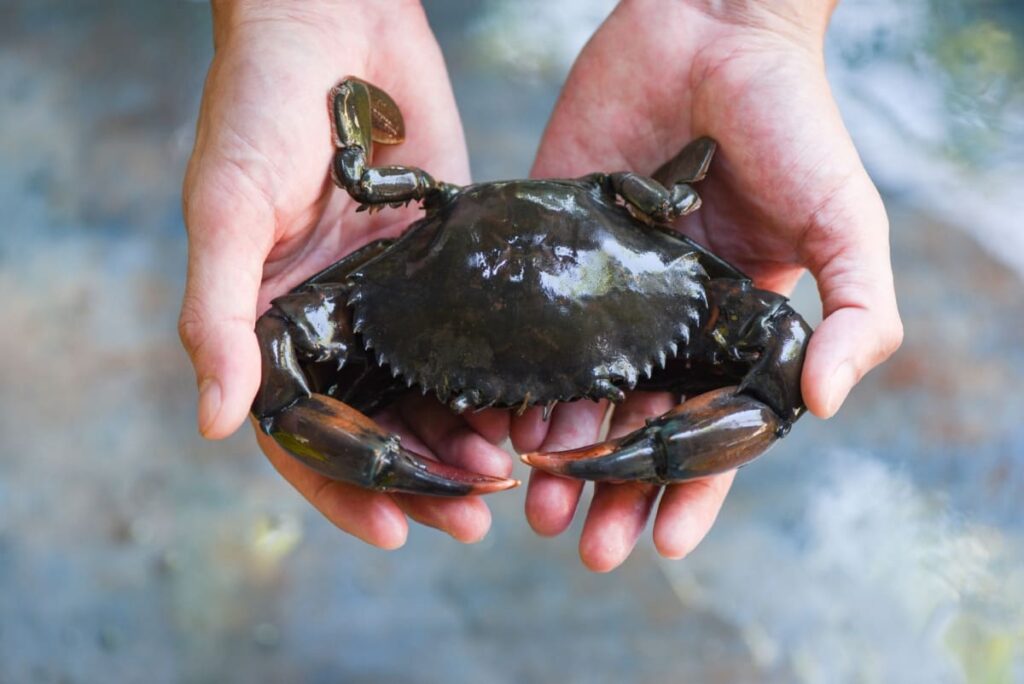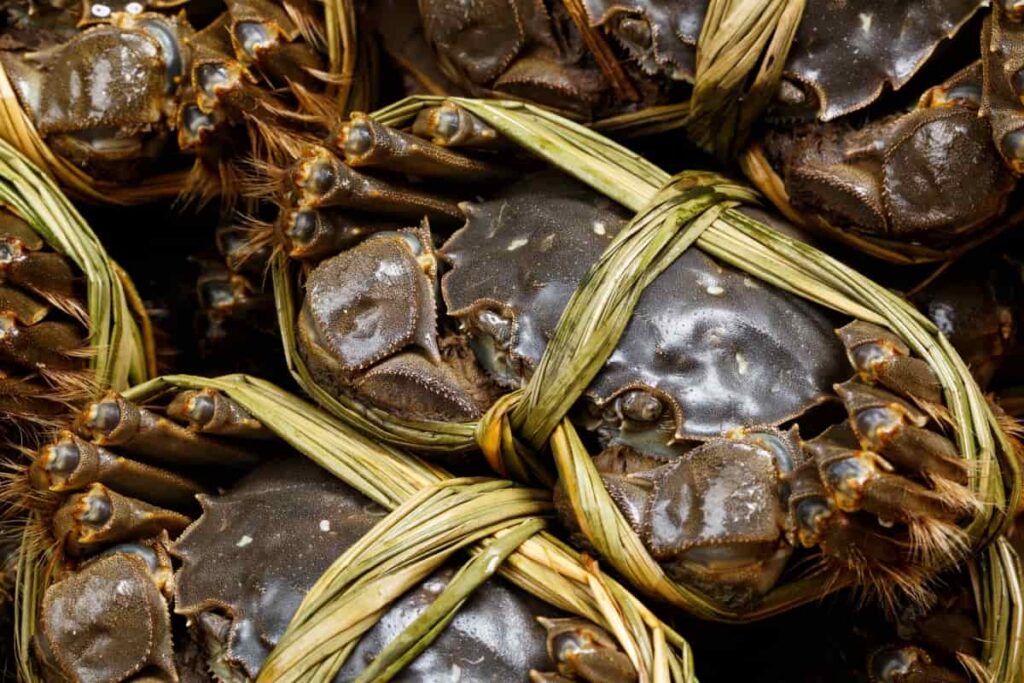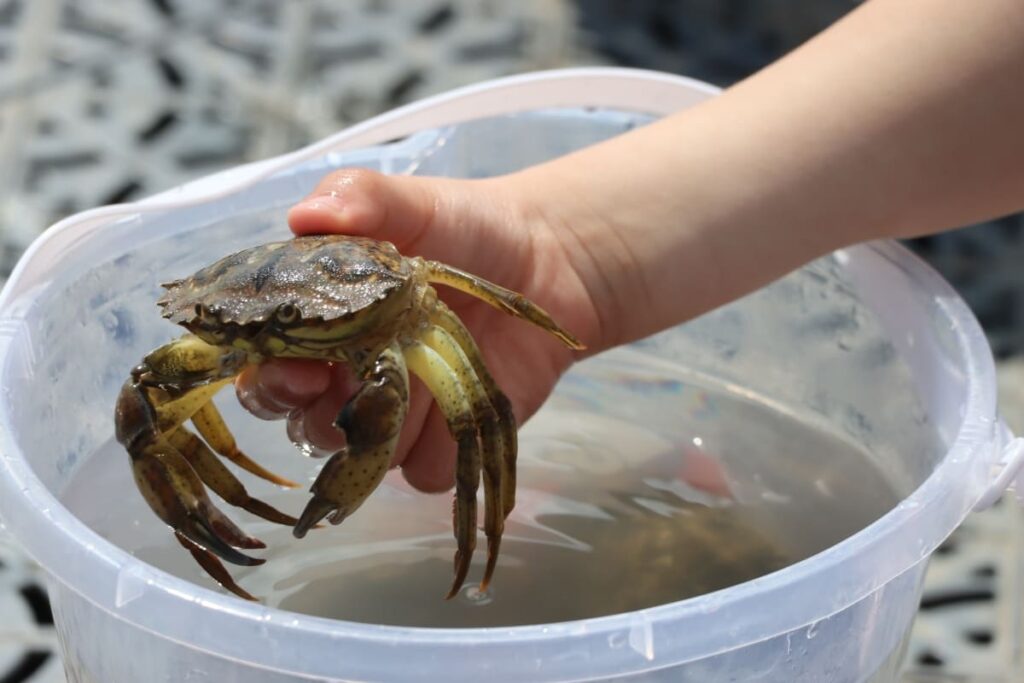Vertical Mud Crab Farming in India is an innovative and sustainable method of culturing crabs in a vertical setup. Unlike traditional horizontal farming, this technique maximizes production while utilizing limited space effectively. By adopting Vertical Mud Crab farming, farmers can overcome geographical limitations and produce a significant quantity of quality mud crabs throughout the year.

Vertical Mud Crab Farming in India
Benefits of Vertical Mud Crab Farming
The main advantage of Vertical Mud Crab farming is its ability to optimize land usage. In densely populated countries like India, where available land is scarce and expensive, vertical setups provide an efficient way to rear large quantities of crabs within a smaller area. Furthermore, vertical farming systems allow for better control over water management and quality control.
Additionally, it provides better control over the environment and water conditions. Another advantage is the reduced labor requirement. In vertical systems, tasks like feeding and monitoring can be automated through the use of technology.
Types of Mud Crabs and Their Suitability for Vertical Farming
- Scylla serrata: Also known as the green mud crab or mangrove crab, Scylla serrata is one of the most commonly farmed species due to its high market demand. It adapts well to crowded conditions, making it ideal for vertical farming setups.
- Scylla olivacea: This hardy species can adapt well to both indoor and outdoor vertical farming systems.
- Scylla tranquebarica: Known as the three-spotted swimming crab or speckled mud crab, Scylla tranquebarica is highly valued for its meat quality and taste.
- Portunus pelagicus: Portunus pelagicus, or blue swimming crab, deserves mention due to its economic significance in coastal regions of India. With proper care and management, this species can thrive in vertically designed systems.
Feed Formulation for Mud Crabs in Vertical System
When formulating feeds for mud crabs in a vertical system, it is important to consider the specific nutritional requirements of these crustaceans. Protein is an important component of their diet as it supports muscle development and overall growth.
In addition to protein, carbohydrates should also be incorporated into the feed. Vitamins play a vital role in maintaining optimal health and preventing diseases among mud crabs. Regular monitoring of water parameters such as dissolved oxygen levels, pH levels, and ammonia concentration is necessary to maintain an optimal environment for efficient feeding activity by mud crabs.
Water Management and Quality Control in Vertical Mud Crab Farms
Water management is crucial for the success of vertical mud crab farms. The water quality directly affects the growth, health, and survival of crabs. An important aspect of water management is monitoring and controlling salinity levels. In addition to salinity, temperature control is also vital.
In case you missed it: Mud Crab Project Report, Culture Profit, and Cost

Optimal temperatures promote better growth and development in mud crabs. Furthermore, oxygen levels should be regularly monitored and maintained at adequate levels for proper respiration of the crabs. Regular checks on pH levels are also necessary to prevent any drastic changes that could harm the crabs.
Cost Analysis and ROI for Vertical Mud Crab Farming in India
The initial investment for setting up a vertical mud crab farm can change based on factors such as location and equipment. Costs may include land acquisition or lease, construction of tanks or raceways, installation of water filtration systems, and purchase of feeding and harvesting equipment.
Calculating ROI involves assessing not only income generated by selling crabs but also factoring in all costs incurred over a specific period. It’s crucial to consider market price fluctuations throughout different seasons as well as production cycles that affect output quantities.
Demand and Profit Potential for Vertical Mud Crab Farming in India
The demand for mud crabs in India has been steadily increasing over the years. With their delicious taste and high nutritional value, mud crabs are a sought-after delicacy in both domestic and international markets. This presents a lucrative opportunity for vertical mud crab farmers. Moreover, vertical farming techniques enable farmers to have better control over production cycles and harvest timing.
| Cost Category | Amount (₹) | Details |
| Initial Investment Costs | ||
| Infrastructure | 2,50,000 | Tanks, recirculation systems, etc. |
| Breeding Stock | 50,000 | Initial purchase of mud crabs |
| Equipment | 1,00,000 | Aeration, water quality systems, etc. |
| Licenses and Permits | 25,000 | Government approvals and permits |
| Total Initial Investment | 4,25,000 | |
| Operational Costs (Annual) | ||
| Feed | 1,50,000 | Diet for crabs |
| Labor | 1,20,000 | Salaries for staff |
| Maintenance | 30,000 | Equipment and facilities maintenance |
| Utilities | 60,000 | Electricity, water, etc. |
| Transportation | 50,000 | Distribution costs |
| Total Annual Operational | 4,10,000 | |
| Total Cost for First Year | 8,35,000 | Initial Investment + Annual Operational |
ROI Calculation
- Assumed Annual Revenue: ₹12,00,000 (Based on market cost and production capacity)
- Net Profit (Annual): Revenue – Annual Operational Cost = ₹12,00,000 – ₹4,10,000 = ₹7,90,000
- ROI: (Net Profit / Total Investment) * 100 = (₹7,90,000 / ₹8,35,000) * 100 ≈ 94.61%
Sustainable Practices in Vertical Mud Crab Farming
Sustainable practices play a crucial role in vertical mud crab farming, ensuring the long-term viability of this innovative method. One such practice is the careful selection and sourcing of seed crabs to minimize any negative impact on wild populations. Another sustainable practice is proper waste management within the vertical farm system.
Implementing efficient filtration systems and regularly monitoring water quality helps maintain a healthy environment for the crabs while minimizing pollution risks. To further enhance sustainability, feed formulation plays a critical role. Proactive disease prevention measures are key to maintaining sustainable operations in vertical mud crab farms. Regular health checks, quarantine procedures for new stocks, and biosecurity protocols all work together to limit disease outbreaks that could devastate entire populations.
Legal and Regulatory Framework for Vertical Mud Crab Farming in India
In India, certain laws and regulations govern this industry to ensure its smooth operation and protection of the environment. The important aspect is obtaining the necessary permits and licenses from relevant government authorities before starting a vertical mud crab farm. These permits may vary depending on the location and size of the farm, as well as the specific regulations set by different states or regions.
In terms of trade restrictions or export-import policies related to mud crabs in India, farmers should stay updated with any changes or requirements imposed by regulatory bodies such as the Marine Products Export Development Authority (MPEDA) or Animal Quarantine & Certification Services (AQCS). By complying with these legal obligations about vertical mud crab farming in India, farmers can operate their businesses ethically while contributing towards sustainable development in the aquaculture sector.
Challenges of Vertical Mud Crab Farming
The main challenge is the need for specialized knowledge and training in crab farming techniques. Farmers must understand the behavior, habitat requirements, and feeding patterns of mud crabs to ensure their optimal growth and survival. Another challenge is maintaining water quality in the vertical system.
Proper filtration systems are crucial to remove waste products and maintain suitable oxygen levels for the crabs. Market demand can fluctuate, posing risks for farmers who rely solely on selling their harvests. Farmers need to have a solid marketing strategy in place before venturing into vertical mud crab farming.
Disease Prevention and Control in Mud Crab Farms
The common disease in mud crab farms is shell disease, which affects the exoskeleton of the crabs. This disease causes lesions or ulcers on their shells, making them vulnerable to infection and other health issues. Another prevalent disease is bacterial infections, which can lead to high mortality rates if not properly managed.
In case you missed it: Mud Crab Farming in the Philippines: Evergreen Profitable Business

These infections often occur when there is a lack of cleanliness in the farm’s environment or when crabs are exposed to unsanitary conditions. Parasitic infestations are also a concern in mud crab farms. To prevent diseases from spreading in your mud crab farm, it is crucial to prioritize good management practices.
The Role of Technology in Enhancing Vertical Mud Crab Farming
Technology has played a main role in revolutionizing various industries, and vertical mud crab farming is no exception. One area where technology has made a big impact is in water quality monitoring. Sensors and automated systems can be used to constantly monitor crucial parameters such as temperature, salinity, pH levels, and dissolved oxygen.
In addition, advancements in aquaculture equipment have contributed to enhancing vertical mud crab farming. High-tech filtration systems help maintain clean water by removing debris and waste products efficiently. Recirculating aquaculture systems (RAS) enable efficient water reuse while minimizing environmental impact.
Indoor Vertical Crab Farming Setup Tips
- Location: When setting up an indoor vertical crab farm, choose a location that provides easy access to water sources and has adequate space for tanks or crates.
- Tank Design and Size: Select tanks or crates that are suitable for vertical farming, allowing crabs to move freely between different levels without overcrowding. Consider the size of the crabs you plan to raise when determining tank dimensions.
- Water Filtration and Lighting System: Install a reliable water filtration system to maintain optimal water quality within the tanks. Adequate lighting is crucial for promoting natural feeding behavior in mud crabs.
- Feeding Management: Implement a well-planned feeding schedule using nutritionally balanced feed formulated specifically for mud crabs in vertical farming systems.
- Routine Monitoring and Maintenance: Regularly monitor critical parameters such as temperature, salinity, pH level, ammonia concentration, dissolved oxygen levels, etc., ensuring they remain within acceptable ranges at all times.
In case you missed it: The Rise of AI in Aquaculture: How Artificial Intelligence is Shaping Fisheries Industry

Conclusion
Vertical Mud Crab farming has gained significant importance in India due to its several benefits and potential for high profits. This innovative farming method allows farmers to maximize production while utilizing limited space. It is an innovative and efficient method of culturing crabs in a vertical setup, making the most of limited space while maximizing production.
- Management Pests and Diseases in Your Cotton Field
- Sheep Farming Business Plan for Beginners
- Aquaponic Farming at Home: A Step-By-Step Guide
- Profitable Village Farming Business Ideas in 2024
- High-Yield Aquaculture: Fast-Growing Fish for Farming
- Effective Fish Pond Construction Techniques for Beginners
- Irrigation and Water Management in Pineapple Farming
- Blossom to Harvest: Mastering Flowering and Pollination in Papaya Farming
- Pig Fattening Essentials: From Selection to Sale for Beginners
